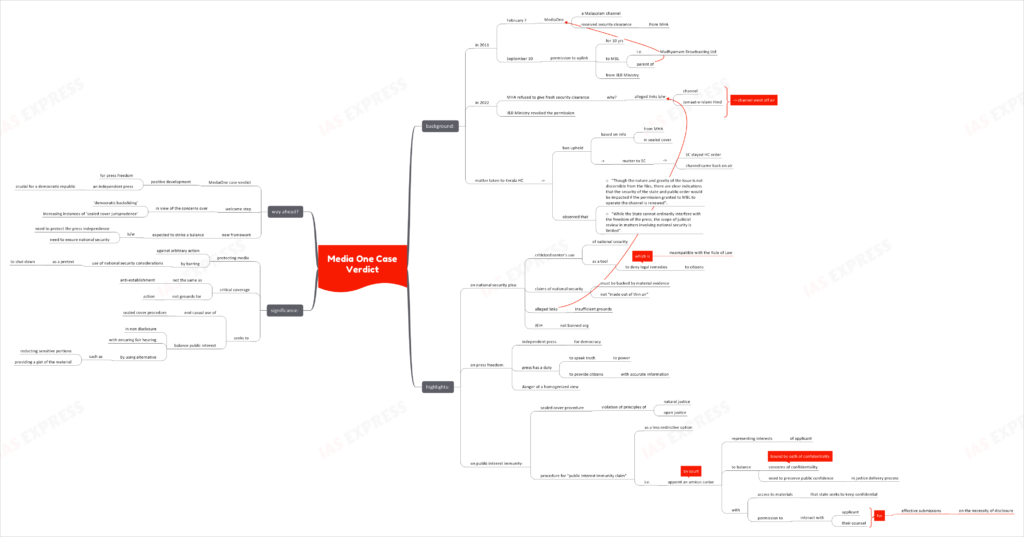Media One Case Verdict- Background, Highlights & Significance

The apex court recently gave its verdict in the Media One case. The verdict has major implications for sealed cover procedures and the rights of the state and the media, with respect to sensitive information.

Background:
- On February 7, 2011, MediaOne (a Malayalam channel) received security clearance from the Home Ministry.
- On September 30, 2011, the Information & Broadcasting Ministry gave Madhyamam Broadcasting Ltd (MBL), MediaOne’s parent, permission to uplink for 10 years.
- On January 31, 2022, the I&B Ministry revoked the permission after the Home Ministry refused to grant fresh security clearance due to alleged links with Jamaat-e-Islami Hind. Following this, the channel went off air.
- The channel took the matter to the Kerala High Court. However, a single Judge Bench of the court ruled upheld the ban. Notably, the High Court relied on information provided by the MHA in a sealed cover.
- The High Court observed that
- “Though the nature and gravity of the issue is not discernible from the files, there are clear indications that the security of the state and public order would be impacted if the permission granted to MBL to operate the channel is renewed”.
- “While the State cannot ordinarily interfere with the freedom of the press, the scope of judicial review in matters involving national security is limited”.
- The channel’s promoters took the matter to the Supreme Court, contending that they weren’t given a chance to defend themselves. In March, 2022, the SC stayed the High Court’s order and allowed the channel to go back on air.
Highlights of Supreme Court Verdict:
Recently, the top court gave its verdict on the case:
On National Security Plea
- The court criticized the Centre’s use of national security as a tool to deny citizens their legal remedies- something that is incompatible with the Rule of Law.
- The court emphasized that claims of national security must be backed by material evidence and not “made out of thin air”.
- The alleged links between the channel and Jamaat-e-Islami Hind were deemed insufficient to justify the denial of security clearance. Moreover, JEIH isn’t a banned organization.
On Press Freedom
- The court stated that an independent press is vital for democracy to function robustly.
- The court emphasized that the press has a duty to speak truth to power and provide citizens with accurate information.
- The court highlighted the danger of a homogenized view on issues.
On Public Interest Immunity
- The court found the sealed cover procedure to be a violation of principles of natural justice and open justice.
- The court devised a procedure for “public interest immunity claim” as a less restrictive option.
- The court can appoint an amicus curiae to balance concerns of confidentiality with the need to preserve public confidence in the justice delivery process.
- The amicus shall have access to the materials sought to be withheld by the state and will be allowed to interact with the applicant and their counsel to enable them to make effective submissions on the necessity of disclosure.
- The amicus shall represent the interests of the applicant and be bound by an oath of confidentiality.
Why is this significant?
- The Court, by barring the use of national security considerations as a pretext to shut down a media outlet, has protected the media against arbitrary action.
- The Court has ruled that the government cannot term critical coverage or airing of critical opinions as “anti-establishment”, and so initiate action.
- The Court seeks to end the casual resort to ‘sealed cover procedure’. While it acknowledges that confidentiality and national security are legitimate aims for the purpose of limiting procedural guarantees, a blanket immunity from disclosure of all reports could not be granted.
- The Court’s judgment seeks to balance the public interest in non-disclosure with the one in ensuring a fair hearing, by suggesting alternatives such as redacting sensitive portions and providing a gist of the material given to the affected party.
What is the way ahead?
- The MediaOne case verdict is a positive development for press freedom in India. As underlined by the court, an independent press is crucial for a democratic republic to function.
- This is also a welcome step in view of the concerns over ‘democratic backsliding’ in India and the increasing instances of ‘sealed cover jurisprudence’.
- The new framework given by the top court is expected to strike a balance between the need to protect the press independence and the need to ensure national security.
Conclusion:
The recent court verdict in MediaOne case is being celebrated as a win for press freedom in India. The new framework given the court is expected to help protect the rights of both- the media and the state.
Practice Question for Mains:
Discuss the significance of the recent Supreme Court verdict in the Media One case, with special reference to the use of sealed cover information. (250 words)
If you like this post, please share your feedback in the comments section below so that we will upload more posts like this.

